The Samsung Galaxy Tab 10.1 isn’t much different from other available tablets on the inside, but we think hardware makes a big difference with a device of this size. Samsung has achieved an engineering feat so impressive that I can’t imagine going with any of their competitors until they match them. Are hardware and design good enough reasons on their own to pick this Honeycomb tablet up? Let’s find out!
Hardware Review
Design/Engineering
The Samsung Galaxy Tab’s hardware can only be described with one word – amazing. And I’m not talking about the internals. The thinness, the lightness, the polish and shine make it a beautiful tablet to look at and a very comfortable one to hold. Samsung vowed to refine their hardware after seeing just how slim and sleek the iPad 2 was and I think they surpassed everyone’s expectations.
It comes in at just 8.6mm thin and weighs just 595 grams light, and more than those numbers look good on paper, they feel great in-hand. Many people say they prefer 7 inch tablets due to comfortability in holding them, but Samsung has crafted a masterpiece that is just as easy to hold in one hand as any small chassis.
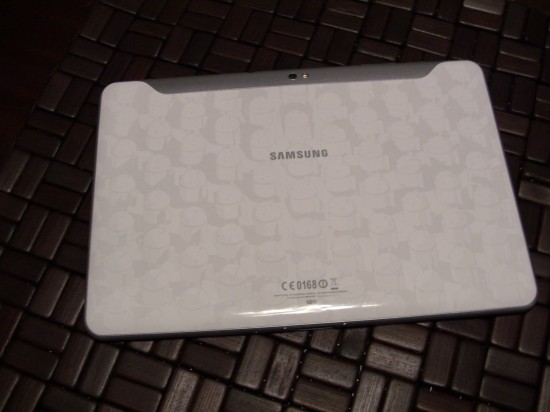
The bezel surrounding the face of the device isn’t as thin as Samsung probably would have wanted it to be, but it’s still damn thin for a tablet. I personally like the bezel size, actually, as it gives me a nice area to grip when holding it i either landscape or portrait. And yes, more of the plasticky feel from their phones make their way to the Tab 10.1.
Most of that can be had on the back of the device. That is largely a preference thing, too – a lot of people like Samsung’s plastic-filled technology and that’s what contributes to how thing and light it is. My Google I/O limited edition Tab 10.1 has a pattern of Android robots on the back. It looks awesome, but retail versions won’t have the same. (You’ll be able to get it with a black or white back.)
Functional Specs
Speaking on the more functional side of things, Samsung had to forego important things such as standard USB ports and SD card slots for that thinness. I was very disappointed by these two omissions, especially after hearing all the cool things that could be done with USB Host support in Android 3.1. It’s worthy to note that the 4G edition of the Tab 10.1 will have an SD card slot. (We are reviewing a WiFi-only model.)
Samsung’s proprietary connector returns for charging, data synching and, eventually, docking. USB host support will depend on compatible adapters made by either Samsung or third party accessory makers, unfortunately. Either way, I hope to see some solution for folks who want to hook up game controllers, mice and keyboards to the Tab. In theory, a standard male-to-male adapter should work, but I have no way of testing this (due to lack of both hardware and software needed).
There are only three hardware buttons – volume up, volume down and power – that contributes to the device’s overall sleek look. I’m a big fan of “less is more” and I hate to see a lot of moving parts on a device. This is characteristic of Samsung’s flagship Android devices so I imagined the Tab 10.1 would get the same treatment.
Inside is a 1GHz dual-core Tegra 2 processor, 1GB of RAM, 32GB of internal storage (other amounts can be had in different configurations), WiFi, Bluetooth, (working) GPS, and a 7,000 mAh battery. Much like every other manufacturer, Samsung chose to go the safe route with internals. I had small hopes of seeing Exynos inside of this thing but Tegra 2 is still sufficient to run Honeycomb smoothly.
Display
The 10.1 inch PLS display on the front is very crisp and vibrant. While the display is better than that of the Motorola XOOM’s (which people claim is washed out and muddy looking), there really isn’t THAT big of a difference. Still, you can tell Samsung used one of their quality displays here and you will be grateful that they did. Not only does it look great, but it’s responsive to the touch and the glass on top seems very durable. (I elected not to put it through the gauntlet for obvious reasons.)
Battery
As for that 7,000 mAh battery, this thing lasts all day long, and then some. In my moderate usage cycles – which consists of a bit of gaming, emailing, chatting, and web browsing a few times within a 10-15 minute period – I’m getting more than a day’s worth of battery life. In periods where I wasn’t using it as much, I’ve pulled more than two days.
In fact, as I write this sentence, I have 40% of battery life left and I am now on two days and seven hours without having to plug it in. This thing could easily reach that third day. On heavier days, I could get just under a day if not a bit more, but even that is quite spectacular. The great thing is that it doesn’t take long to charge, either. It will quickly become your favorite travel accessory as it won’t be often that you’ll have to worry about stopping to juice up.
The only negative I can muster up is that the battery is not user replaceable, meaning the back cover cannot be detached unless you void your warranty. (And it might permanently screw the device up – I’d definitely urge you to stay away from trying it.) I wouldn’t care if not for some annoying issues on the software side of things. We’ll take a look at that right now.
Software Review
No TouchWiz, but not really
Despite what we learned at CTIA – that the Galaxy Tab 10.1 would have Samsung’s lightly-customized TouchWiz UI with Live Panels and the mini apps tray – our limited edition Galaxy Tab 10.1 didn’t come with many of those customizations. We don’t expect that to be the case for the consumer version of this tablet, though. This is stock Honeycomb 3.0.1 for the most part, with the only hints of Samsung being their Music Hub application, the camera application and their own keyboard. There are a few more preinstalled applications, too, such as QuickOffice and Samsung’s Apps store. Samsung Apps was very dry as of the time of writing this review. The only thing that could be found there were test applications, likely from Samsung themselves. We expect things to change once these hit retail shelves and they sway more developers to publish their apps there.
Nothing is without its problems
Honeycomb is Honeycomb – we’ve seen it before and not much is different since the first device was launched in March. We would like to imagine Honeycomb 3.1 will be on retail units when they launch, but the jury is still out on that. NVIDIA’s Tegra 2 chipset is just as good as it was a couple of months ago. It can handle Honeycomb and can handle it beautifully. The only time I experience performance hiccups (outside of major freezes likely caused by premature software) is when I have the tablet in portrait mode (it’s especially noticeable in YouTube where you can see a clear drop in playback framerate, as well as in the browser where scrolling isn’t as smooth), but that is even true with other Honeycomb devices. We’re beginning to think it’s an issue at the core of the operating system.
Overall, though, Honeycomb performs very well – more-so than it did on Motorola’s XOOM. (Though we hear recent updates have cleared a lot of those issues up.) That’s not to say that there aren’t any issues, however. Any application using webview may be deemed useless after only a few minutes of use as webkit randomly likes to become unresponsive. I often found myself unable to scroll or click on links. The application themselves don’t in these instances as I’m able to use everything outside of the webkit renderer. It’s a very frustrating issue that can only be fixed by exiting and reentering an application and it’s one I hope Samsung will fix.
Beyond webkit, this thing has a habit of force closing from time to time. YouTube, Google Maps and Music Hub were the main culprits. In fact, this issue was preventing me from even trying Music Hub. Alongside those Honeycomb-specific applications, those not yet optimized for tablets worked, but you may experience issues with certain applications that just can’t be helped until the developers responsible adapt them for Android 3.0+.
Where a user-replaceable battery would help
Going even further, I’ve had a couple of cases where my device wouldn’t awake from sleep. It’s not unlike problems I’ve had with phones, but the major issue here is that you can’t just pry the battery out and reboot. I had to try a combination of the volume up/down buttons and the power buttons to get the tablet to reboot in each instance and I’m still not exactly sure what combination it was. (I only found out after maniacally mashing all of the buttons.)
Considering the consumer version of this device isn’t set to release until June 8th, it’s kind of tough to knock Samsung for all of these things. Still, we believe the hardware is pretty final and the software hasn’t been altered too much outside of the addition of a few apps. We’re hoping updates to come after the consumer device officially launches will fix most of these issues.
Camera, Media, Odds, Ends
No zoom? Really?
Samsung didn’t do anything special with the cameras here. You have a 3 megapixel shooter on the back accompanied by a lone LED flash. You also have a front-facing camera for video calling and self portraits. They’re driven by Samsung’s own camera application which provides an abundance of options to help you take that perfect shot. (That’s aside from two glaring omissions, anyway – the lack of zoom options and the inability to disable sound.) Unfortunately, the camera itself was a bit disappointing compared to what they offer on phones.
Photos taken inside were quite grainy, even with a good amount of lighting. (Take a look at the candle photo below for an example.) Outside was a bit better, but it wasn’t great. A few close-up photos taken in macro mode was as pretty as it got, but trying to get a fair-sized subject into the entire shot exposed how underpowered the sensor is. I was even moreso surprised by the fact that the front-facing camera sometimes produced better images than the main 5 megapixel camera in the same lighting conditions.
Video performance was decent in natural lighting, but nothing amazing. And it was absolutely horrible inside. The HD video taken outside didn’t come out as bad as video taken inside under fluorescent lighting, but it still wasn’t as good as I thought it’d be. Sound quality was decent, though, and the framerate was smooth enough.
Samsung remains near the top of the list for camera performance in Android phones, and while it probably isn’t as bad as I’m making it out to be, I feel they missed the mark – whatever that mark is – on the Tab 10.1.
As far as music goes, you’re left with the stock Honeycomb music player. I don’t mean for that to sound like a bad thing, though – the new music app is completely awesome. If only for the cloud streaming features alone, I had no problem with making this my default for tunes. I still wish Google would put a bit more into their applications as far as sound enhancement and other options go, but it’s solid as is. (I couldn’t store any of my own music locally. More on that below.) As I mentioned before, Samsung’s Music Hub proved quite useless to me as it would do nothing but force close every time I opened the application. Playing that music back was great, as well, thanks to Samsung’s high quality speakers on the sides of the device.
A quick note about web browsing with flash – I had flash content loading at all times and performance wasn’t significantly hindered by ads or embedded videos. In fact, I barely noticed they were there half the time. And as far as playing those videos go, they performed smoothly inside the stock browser, even when playing the content in high definition.
Yes, GPS works
Broken GPS was a bit of a cruel joke throughout the launch of the original Galaxy S, but people still haven’t put trust into Samsung when it comes to GPS. I know you folks want to know if it works, and the answer is yes. And it works very well. I was able to get a lock within a few seconds of starting up Google Maps or Foursquare and the radius in which it had me was very accurate.
File transfer and storage
This is, by far, one of the most annoying times I’ve had with an Android device. I plug the device into my computer, I open the Android File Transfer Utility (for Mac users) and the device says I’m connected. Yet, the transfer utility does not recognize it and the Tab does not show up in Finder. Doing a bit of searching, I come across a sea of complaints from users who have had the same issues. If I wanted to listen to any of my own music, I had to stream it or use Google Music. And I couldn’t even pull sample images and video off easily.
I had to directly upload video to YouTube (if you know me, I hate uploading from anything but a PC), and I had to use Picasa for the images (again, a pain considering I don’t even use Picasa). I wouldn’t have been as annoyed if I could have just used my SD card, but as I mentioned in the hardware portion, there is no SD card slot. It seems to only be affecting the Limited Edition Galaxy Tab 10.1 devices, though, as others with the retail version have not had much trouble. Let’s hope the same is true for the US version set to launch in June.
The Verdict
There isn’t much going on with the tab when put up against competitors such as the Motorola XOOM, the Eee Pad Transformer, and the Iconia Tab, but the hardware is unmatched by any tablet manufacturer regardless of what operating system they use, and the software hasn’t been mucked with that much. (I must admit, though – I’m quite fond of the mini apps tray that will be found on the consumer version of the Tab 10.1.)
Honeycomb still seems quite immature at this point, but we haven’t been reviewing the absolute latest version (Android 3.1) and things could change once Samsung does offer that update. The context in which we received the device must be considered – it was given to thousands of developers for the purpose of pushing Honeycomb application development along. Samsung probably figured code monkeys would put up with the problems until they could issue a more stable update. Hell, they aren’t even offering customer service for the I/O edition of the Tab 10.1 until June 8th. For that reason, I can’t say for certain whether or not these issues will turn up in the consumer version of the Tab 10.1.
I’ll give Samsung the benefit of doubt here, but take my experience into consideration before plopping down a minimum of $500 for this thing. If I were to go on hardware alone, I’d consider this a must buy. And even if I brought software into the mix, I’d say take the chance for this fantastic piece of hardware. It’s a solid tablet with some annoying software-based issues, but it is still one of the finest Honeycomb tablets on the market.


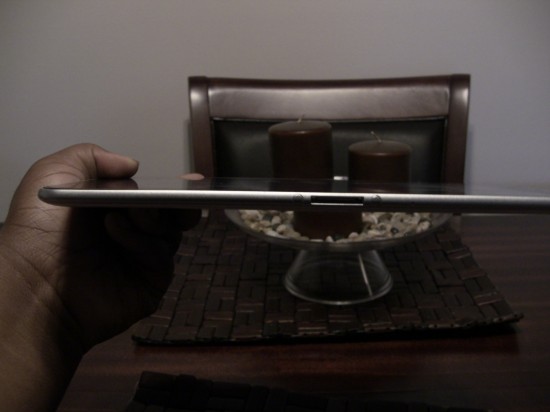
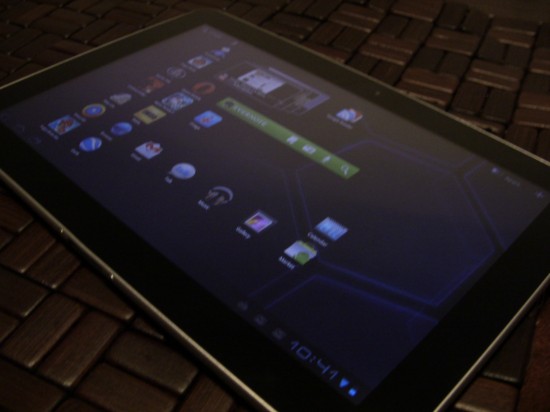
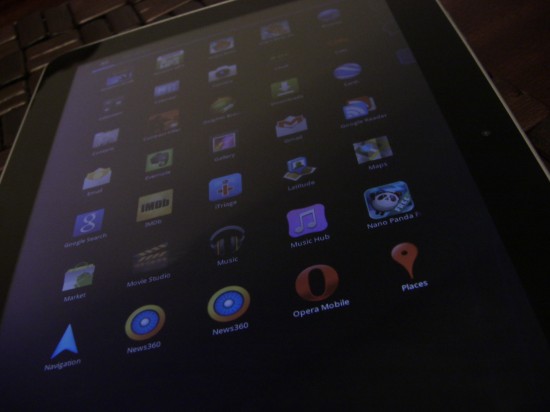
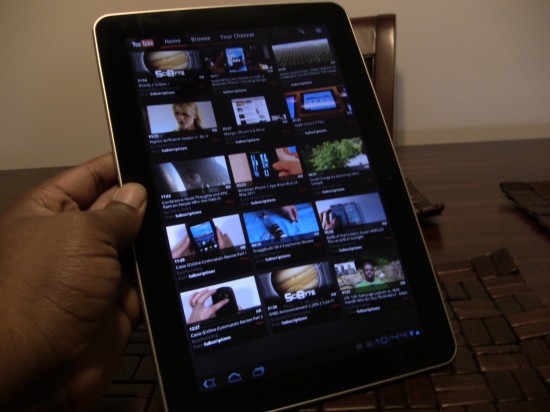
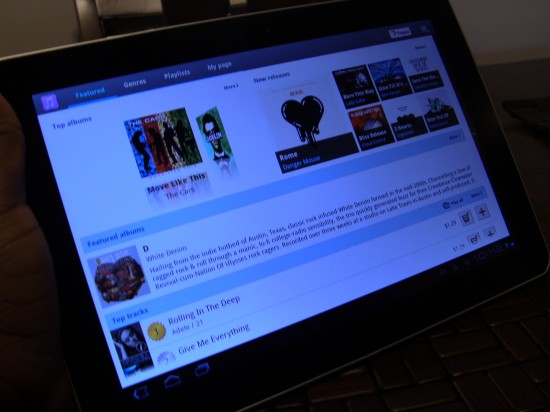
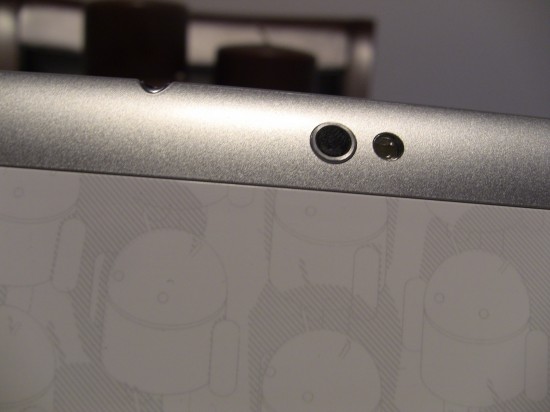
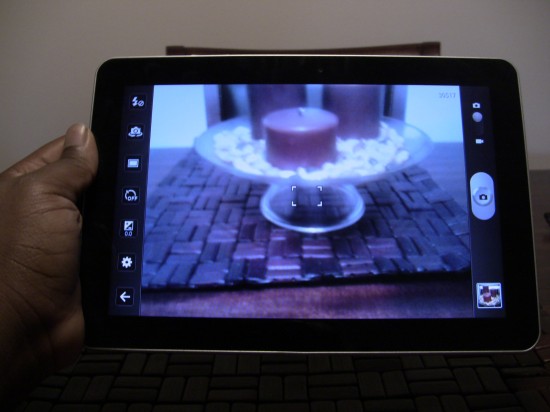




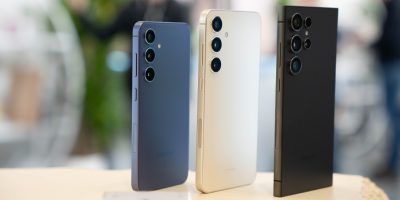



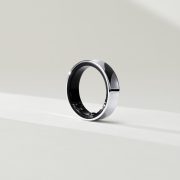



Wow – more fire for that Apple lawsuit (single proprietary connection, only volume buttons, etc). Anyone else SICK of all the manufacturers putting proprietary connections on their devices. The zoom power cord was bad enough (ours went missing on our first trip with it – there goes $40), but this thing doesn’t even have a USB port.
Just buy a friggin USB connection kit and get over it.
http://www.samsung.de/de/Privatkunden/Mobil/Mobiltelefone/Zubehoer/epl1plr/EPL-1PLRBEGSTD/accdetail.aspx?atab=features
How often are you really going to keep USB devices plugged into your tablet? I, for one, would rather have a thin tablet with a proprietary connector than a fat tablet with standard USB port.
Your argument is invalid.
http://www.mobilitysite.com/wp-content/uploads/2009/11/usbconnects1.jpg
Two European standardization bodies have agreed to make micro-USB the standard interface port for smartphones in Europe.
http://reviews.cnet.com/8301-31747_7-20026874-243.html
Yeah, but not when the device is acting as a host, right? How many mini-USB-to-mini-USB cables do you own?
And no HDMI out? WTH?
But this tablet still lacks microsd card… sorry, because of this reason I rather just buy a ipad 2… Why is Samsung copying apple stuff anyways? Can’t they come up with their own tablet design and cellphone design? Plus, Samsung have one of the worst software support for their phones and tablets… That’s why I will never purchase another Samsung product.
Yes, i’m sick of the proprietary devices, too. Most people I know are…they put up with it because they have to. With all of the devices I have, carrying around cables and adapters is a drag.
And “get over it” doesn’t really cut it for consumers that buy these things for the convenience factor, only have the burden placed on the consumer to accessorize.
It’s PDMI, http://en.wikipedia.org/wiki/PDMI ..
It’s amazing how much smoother the IO tab is than the Xoom even though they have pretty much the same internals. I’m sure that 3.1 will fix things for the IO tab. It made a huge difference on the Xoom and from my experience there were more issues on the Xoom 3.0. It was really rushed. I’d be willing to bet they have better camera software and zoom with the pending update.
The fact this tablet has proprietary connections, no SD slot, and no USB ports are the reasons for me to not want it. Android 3.1 has USB capabilities that cannot be accessed with this tablet unless docked. It is unfortunate, because it does look very impressive. So far the Transformer is the most appealing of the Android tabs for me; however, I am still going to wait a little longer before I decide given the additional tablets coming out.
The big issue I had with the Xoom’s screen was pixel density. It was pretty easy to see that gaps between each pixel. I don’t see any mention about that in this review. Can anyone confirm whether the situation has improved or not with the 10.1?
Its a PLS display, not an IPS display.
http://www.anandtech.com/show/4233/samsungs-galaxy-tab-101-89-smaller-than-ipad-2-competitively-priced
phandroid misses some pretty obvious stuff sometimes. They were using a picture of the 10.1v to represent the new 10.1 for quite a while. Ugh.
Edit: Not to be a jerk, though. I appreciate the review :) I’ve been clamoring for every detail on the 10.1 possible.
odd, the Samsung rep I’ve spoken to about it said it had an IPS display. After looking into it, though, you’re right. Edited post (can’t edit video)
The USB adapter that comes with the power adapter of the Galaxy Tab 10.1 “Google IO edition” can be used to connect to your PC for development and debugging. I tried it and it works fine. I suspect that the entire USB Host and USB Client interface are there, although ‘obstructed’ by the proprietary port on the bottom.
As long as Samsung (or another manufacturer) makes proper adapter cables/dongles, it all should work fine, i think.
But I still don’t like the proprietary port. Can’t reuse my existing USB or HDMI cables…
Yes, you can still re-use your cables. You’ll just have to plug them into a proprietary adapter.
“It’s worthy to note that the 4G edition of the Tab 10.1 will have an SD card slot.”
Has a carrier been confirmed for this? I want to buy the Wifi version when it is released, but only if I know Sprint isn’t going to turn around and release a 4G Wimax version two weeks later.
Samsung mentioned it would sell an LTE version, so I assume it’ll be Verizon. But now AT&T is also getting an LTE network, so who knows.
It’s a nice device, but I will say my faith in my Xoom purchase was renewed when I _finally) figured out it was considered a Google experience device and get’s it’s updates direct from Google (as evidence in Google I/O when they started rollouts on announcement).
That’s worth the extra money to me … and I’ll be watching _very_ closely how quickly other devices get their updates in the future especially to icecream … major upgrades seem to “sit” with vendors forever (read: gingerbread). Basially I want to see if this “update pledge” has any teeth.
Great review. Thanks for the info.
The only thing I’d add is that I’ve been disappointed by the marketing of this product. They haven’t been very forthcoming with information about its release or when carriers will make it available for my wireless plan. I would have liked to have seen a pre-order process, either through Samsung or through my carrier.
PHILIP DEFRANCO!!! <3333
Nice review, can't wait to get my hands on this beast.
The won’t-wake-up problem seems to be a common issue. I ran into it with mine, too, and found a forum post explaining the workaround (volume-down and power):
http://www.thegalaxytabforum.com/index.php?/topic/3324-samsung-101-dead-after-overnight-charge/
It doesn’t have a usb port or sd card slot? Does it have an hdmi port at least?
nope…just like my Vibrant…AV out the headphones jack. Thin-great…light-great…connectivity-completely lacking.
I thought Phandroid was going to be giving one of these away…… ;)
While I know it’s widely frowned upon by my fellow developers, after using the tablet for about 3 days and seeing its shortcomings, I sold it on eBay. I figured $800 would be enough to buy it retail later on (once HC gets its sh*t together) and still have spare change in the bank.
Er, maybe I missed something but I don’t see how the hardware on this is any better than the other tablets.
hrmmm let’s compare it to the xoom. while the xoom has similar specs, the sammy is thinner and lighter and feels more solid. this is supposed to be a portable device so thinner and lighter IS better :)
Yeah, except to do it they had to strip stuff out that the other tablets have. When it comes down to it, the difference in size and weight is just masturbating over numbers at this point. They’re kind of going beyond the diminishing returns. I guarantee that most people can’t remember the thinnest and lightest cellphone made.
I’m really really disappointed with the proprietary USB connector. I wish it was micro usb, and if the form factor of the micro USB connector is too big for the thinkness of the device, we need a smaller standard everyone can use. I hate proprietary connections.
About he camera:
The back-facing camera is about 3MPixel, not 5.
Also, for a 3MPixel camera, it produces decent results. I was pleasantly surprised. The picture you took of the candles looks horrible, because the shutter time was too long and the picture shows a lot of motion-blur.
Zoom functions on camera-phones are overrated. They are 99% of the time digital-zoom. If actual zoom is not supported (zooming done by the lens itself) and it is all digital zoom, the zoom function is near useless. Doing a crop yourself after the picture has been taken gives the same result.
For the rest, it is a great review. Thanks!
I think this thing is fantastic. But after finding out it has zero ports (as every other Droid device) and the Prod version will have a TouchWhiz on it – I think I’m going to have to pass. Its so sad really. Why do companies wreck the true Google experience with skins, it’s simply sad.
oh forget this junk. The Tegra 2 is so overhyped. “Exclusive games”..gimme a break. Where is the S2? Need it now my crappy phone is on the fritz. Don’t wanna upgrade to an Infuse.
3MP not 5MP rear camera
Isnt some lucky phandroid reader supposed to win this thing? When we that phandroid be announced?
no usb – hmm ok
no hdmi – that kinda sucks
no micro sd?? – deal breaker
I use File Manager HD on my Iconia Tab which allows file transfers over WiFi. Even works with the external SD Card AND USB Flash drive. Give that a try to transfer files to this device.
Good Review, Would have been nice to see some more comparisons ie to the iPad2 or 10.1V (on sale outside, the US. ) Specifically that it is a bit wider and lighter than the iPad2 is a noticeable thing, or query why the thinner 10.1 is lower spec than the 8MP 10.1V etc. I am doing such as review on a Honeycomb Acer A500, vs Xoom, vs 10.1G, vs iPad2, vs 10.1V in a few days on news-knut.net or @mr_internet. Finally the big mystery is if the microSD slot not in the 10.1G or 10.1V will appear or not when it goes on sale 8 June in USA and 15 June in Australia (and likely Europe)
This is just an ipad 2, but with a buggy OS!
… and no apps
Asus Transformer FTW.
I’m glad Samsung gave these out for IO. That allowed me to see what it consisted of and how much it was lacking. No HDMI???? No USB??? Most importantly… No MicroSD???? What are you thinking Samsung?
Lets not forget the fact that it’s made by Samsung so owners should get 3.1 by 2012.
Great read…good infomation for my future purchase. Almost bought a zoom…Once bestbuy has them in stock. I’ll check it ..out